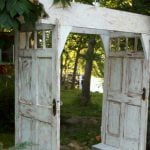Are you looking for nice ideas for small gardens to maximize the potential of your limited outdoor space? Many people believe that a beautiful garden requires a large plot of land, but in reality, small gardens can be just as stunning and impressive as their larger counterparts.
In this article, we will explore why small gardens can be just as beautiful as large ones and provide you with tips, tricks, and inspiration to transform your petite outdoor space into an oasis of natural beauty.
When it comes to gardening in limited space, choosing the right plants is crucial. We will discuss how to select the perfect plants for small gardens, taking into account factors such as size, shape, and maintenance requirements. Additionally, we will explore creative ways to use vertical space to maximize plant and decor options, as well as the art of container gardening to create a stunning display in limited space.
Furthermore, we will delve into techniques for utilizing color and texture to create visual interest in a small garden. From small-scale landscaping to practical maintenance tips and real-life examples of successful small garden designs, this article is your ultimate guide to embracing the potential of small gardens for beauty and creativity.
Whether you have a tiny urban balcony or a small backyard, with the right ideas and inspirations, you can turn your compact outdoor space into a breathtaking garden retreat.
Choosing the Right Plants for Small Gardens
Choosing the right plants for a small garden can make a big difference in maximizing the space and creating a beautiful and functional outdoor area. There are several important factors to consider when selecting plants for a small garden, such as size, growth habit, and maintenance requirements.
One key tip for choosing the right plants for small gardens is to opt for compact or dwarf varieties. These types of plants take up less space and are well-suited for container gardening or small planting beds. Additionally, selecting plants with a slow growth habit can help prevent overcrowding in a limited area.
Another nice idea for small gardens is to focus on multi-functional plants that offer visual interest as well as practical benefits. For example, selecting herbs or edible flowers not only adds color and texture to the garden but also provides fresh ingredients for cooking. Similarly, choosing flowering plants that attract pollinators can contribute to the overall health of the garden ecosystem.
When it comes to plant selection for small gardens, it’s also important to consider maintenance requirements. Opting for low-maintenance plants can make it easier to keep a small garden looking its best without requiring excessive time and effort. Additionally, choosing native or drought-tolerant plant species can help conserve water resources while still adding beauty to the garden space.
| Factors | Tips |
|---|---|
| Size and Growth Habit | Choose compact or dwarf varieties; Select slow-growing plants |
| Multi-Functional Plants | Opt for herbs or edible flowers; Choose flowering plants that attract pollinators |
| Maintenance Requirements | Select low-maintenance plants; Choose native or drought-tolerant species |
Creative Use of Vertical Space
When it comes to small gardens, maximizing space is key to creating a beautiful and functional outdoor oasis. One great way to do this is by making creative use of vertical space. By utilizing walls, trellises, and other vertical structures, you can expand your planting and decor options in exciting ways.
Here are some nice ideas for small gardens to make the most of vertical space:
- Vertical Gardens: Consider creating a living wall with an array of plants that can thrive in a vertical environment. This not only adds visual interest but also maximizes planting space.
- Hanging Planters: Utilize hanging planters to add greenery without taking up valuable ground space. You can hang them from pergolas, trees, or even create a DIY hanging planter system.
- Wall-Mounted Decor: In addition to plants, think about incorporating wall-mounted decor such as outdoor artwork, mirrors, or decorative shelves to add personality and style to your small garden.
By thinking outside the box and looking up for inspiration, you can transform your small garden into a lush and inviting space that makes the most of every inch.
Remember that when making use of vertical space in your garden’s design scheme it’s important to consider proper irrigation and maintenance access to ensure the success of your greenery. With these suggestions for using vertical space, you will be well on your way to creating a stunning small garden that defies its limited dimensions.
Container Gardening
Choosing the Right Containers
When it comes to container gardening in a small space, choosing the right containers is essential. Opt for pots and planters that not only complement your garden’s overall style but also suit the size and needs of the plants you wish to grow. Consider hanging baskets, window boxes, tiered plant stands, and wall-mounted containers to maximize vertical space and create visual interest.
Selecting Plants Wisely
Selecting the right plants is crucial for successful container gardening in a small space. Choose varieties that are well-suited to growing in containers and that will thrive in your specific growing conditions. For added impact, opt for plants with varying heights, colors, textures, and growth habits to create an eye-catching display. Mixing flowers, herbs, ornamental grasses, and foliage plants can add depth and vibrancy to your small garden.
Creative Arrangements and Maintenance
Get creative with how you arrange your containers in your small garden space. Consider grouping pots together to create focal points or using them to line paths or define different areas within your garden.
Regular maintenance is key to keeping your container garden looking its best – water regularly, feed as needed, prune or deadhead spent blooms, and keep an eye out for pests or diseases. With proper care and attention, your container garden can be a stunning focal point in your small outdoor space.
With these nice ideas for small gardens when it comes to container gardening, you can transform even the tiniest outdoor areas into lush and beautiful havens. Whether you have a balcony, patio, or just a small patch of ground outside your home, container gardening offers endless possibilities for creating captivating displays of nature’s beauty.
Utilizing Color and Texture
When it comes to small gardens, utilizing color and texture is essential for creating visual interest in a limited space. By carefully selecting plants with varying colors, leaf shapes, and textures, you can add depth and dimension to your garden, making it look visually stunning despite its size.
One nice idea for small gardens is to use a mix of vibrant flowers and foliage to create pops of color throughout the space. You can choose a color scheme that complements your home or outdoor decor, or go for a more eclectic look with a diverse range of hues. Incorporating different textures such as smooth leaves, fluffy grasses, and rough bark can also add another layer of interest to your garden.
In addition to plant selection, incorporating hardscaping elements such as decorative stones or pathways can also contribute to the overall visual appeal of your small garden. By adding these features strategically, you can break up the space and create focal points that draw the eye throughout the garden.
Another great way to add color and texture is by using containers and hanging baskets. These allow you to introduce an array of plants into your small garden without taking up valuable ground space. Whether you opt for flowers with bold hues or cascading greenery with interesting foliage patterns, container gardening offers endless possibilities for adding visual interest to your small garden.
Small-Scale Landscaping
When it comes to small-scale landscaping, designing paths, borders, and features in a small garden can make a big impact. With the right design choices, you can create a sense of depth and interest in even the most petite outdoor spaces. Here are some tips for making the most of your small garden when it comes to landscaping:
- Use curved pathways: Instead of straight lines, consider using curved paths to add a sense of movement and intrigue to your garden. This can also create the illusion of more space.
- Choose plants strategically: When designing borders, opt for plants that are well-suited to small gardens. Look for compact varieties that won’t overwhelm the space but still provide visual interest.
- Incorporate focal points: Whether it’s a small fountain, a sculpture, or an ornate bench, adding a focal point can draw the eye and create a feeling of expansiveness in your garden.
By carefully planning the layout of your pathways, borders, and features, you can make the most of every inch in your small garden and create a beautiful outdoor retreat.
Utilizing Vertical Space: Maximizing Plant and Decor Options
One of the challenges of gardening in a small space is finding room for both plants and decorative elements. However, by utilizing vertical space effectively, you can maximize your options for creating a stunning display. Here are some ideas for making the most of vertical space in your small garden:
- Install hanging planters: Hanging planters allow you to grow flowers and foliage without taking up valuable ground space. They also add visual interest at different heights.
- Use trellises or wall-mounted planters: By growing climbing plants on trellises or using wall-mounted planters, you can create lush greenery that doesn’t encroach on floor space.
- Add vertical décor: Consider incorporating vertical elements such as outdoor art pieces or mirrors to add depth and personality to your small garden.
By thinking creatively about how to use vertical space, you can open up new possibilities for your small garden while adding character and charm to the overall design.
Practical Tips for Maintenance
Regular Watering and Feeding
In a small garden, it’s essential to stay on top of watering and feeding your plants. With limited soil space, the nutrients can quickly become depleted, leading to lackluster growth. Consider using a drip irrigation system or self-watering containers to ensure consistent moisture for your plants. Additionally, incorporating slow-release fertilizer pellets or liquid feed can help keep your plants healthy and vibrant.
Weeding and Pest Control
Small gardens are especially susceptible to weed growth and pest infestations due to the close proximity of plants. Regularly inspect your garden for any signs of weeds or pests, and promptly remove or treat them as needed. Mulching can also be an effective way to suppress weed growth while adding visual appeal to your garden.
Pruning and Trimming
To maintain a tidy and well-kept appearance in your small garden, it’s important to schedule regular pruning and trimming sessions. This not only keeps your plants looking neat but also promotes healthy growth. Trim back overgrown foliage, deadhead spent flowers, and shape shrubs as necessary to ensure your garden remains visually appealing.
By implementing these practical maintenance tips, you can keep your small garden looking great throughout the year, allowing you to fully enjoy the beauty of your outdoor space without feeling overwhelmed by upkeep.
Small Garden Design Inspiration
When it comes to small garden design, there is no shortage of inspiration from real-life examples and success stories. Many homeowners have managed to create stunning and functional outdoor spaces, even with limited square footage. By drawing inspiration from these examples, you can find nice ideas for small gardens that suit your own personal style and preferences.
One popular trend in small garden design is the concept of creating different zones within the space. For example, you might carve out a cozy seating area using stylish outdoor furniture, surrounded by lush greenery and colorful blooms.
At the same time, you could also incorporate a small vegetable or herb garden, adding both beauty and functionality to your outdoor space. Looking at real-life examples of how others have divided their small gardens into various zones can provide valuable insight into how you can do the same in your own yard.
In addition to zoning, considering the use of vertical space is another key aspect of successful small garden design. By looking at real-life examples of vertical gardening techniques, such as installing trellises for climbing plants or using hanging planters, you can discover innovative ways to maximize planting options without taking up valuable ground space.
These creative uses of vertical space can help you make the most out of your small garden without sacrificing style or variety in your plant choices.
Conclusion
In conclusion, small gardens have proved to be a wonderful canvas for creativity and beauty. As highlighted in this article, there are numerous ways to make the most of limited space and create stunning outdoor sanctuaries. By choosing the right plants, maximizing vertical space, utilizing container gardening, playing with color and texture, and incorporating small-scale landscaping elements, small garden owners can truly bring their outdoor spaces to life.
The possibilities for creating a beautiful small garden are endless and inspiring. With the right knowledge and a bit of creativity, anyone can transform a tiny outdoor area into a lush and inviting oasis. Whether it’s through carefully selecting the perfect plants or strategically arranging features like paths or borders, small garden owners have plenty of tools at their disposal to turn their visions into reality.
It’s clear that size doesn’t determine the potential for beauty in a garden. In fact, as demonstrated in this article, some of the most innovative and charming garden designs hail from tight spaces.
The key is to embrace the unique challenges of working with limited room and find ways to turn those limitations into strengths. By doing so, small garden owners can discover an abundance of
Frequently Asked Questions
How Can I Make My Small Garden Nice?
Making your small garden nice involves careful planning and design. Consider using vertical space with hanging gardens or trellises, choosing low-maintenance plants, and incorporating pops of color with colorful containers or ornaments.
What Is Best for a Small Garden?
The best approach for a small garden is to focus on maximizing the space available. This means selecting compact or dwarf varieties of plants, using containers and raised beds, and creating different levels with shelves or tiered planters.
How Do You Maximize a Small Garden?
To maximize a small garden, consider utilizing every inch of space efficiently. This can be achieved by using vertical gardening techniques, incorporating multipurpose furniture such as benches with storage, and carefully planning the layout to create the illusion of more space.

Welcome to my gardening blog! I am passionate about plants and enjoy sharing my knowledge and experiences with others. In this blog, I will write about everything related to gardening, from tips on how to get started to updates on my own garden projects.





